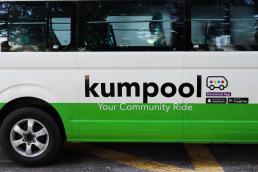How do you break into a market dominated by a major player? This is the conundrum faced by many ridesharing services that have to go up against Grab. The behemoth company is a major player across Southeast Asia, commanding a 95% market share.
For Kumpool, the gap is to offer an on-demand mini-bus service — different from other players in the market who only offer private cars. The ridesharing service has been operating in Johor Bahru since December 2019 and has recently decided to foray into the Klang Valley. But will they be successful? More importantly, can their distinct offering set them apart in a saturated, yet dominated urban ridesharing market?
User experience assessment
Booking a ride
Members of the Malaysian Land Public Transport Fans group (including myself) were invited to join their pilot launch on 15th December last week. We gathered at the Subang KTM/LRT station early in the morning. We were shortly after joined by the Kumpool team.
From this point onward, we were encouraged to book a ride using the application, which can be found on both iOS and Android platforms.
Kumpool’s landing page leads you to a chatbox user interface (UI), which is a trend that has gained popularity across many digital platforms. The use of a chatbox simplifies the experience and is intuitive. We were told that because Kumpool is aiming at a wide range of users across different age groups, the chatbox function was most friendliest for the elderly. This thinking makes sense as chatboxes are meant to emulate text conversations by both design and logic.
You are offered options to choose from in the conversation. To start, we picked Book now.
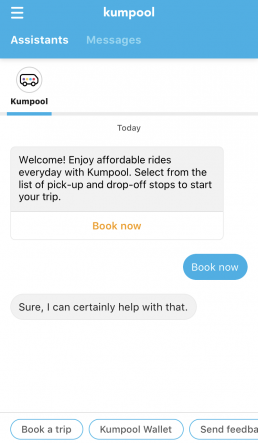
The landing page.
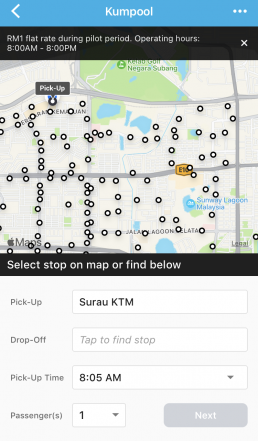
Pick-up stops close to you.
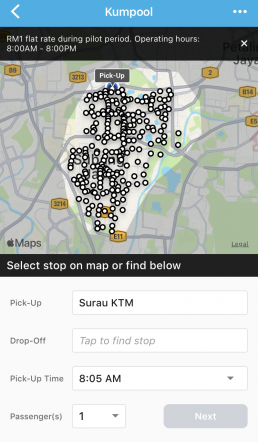
Kumpool’s coverage in Subang.
After which, you will be brought to a screen that shows your current location (provided you enabled your phone location), and the closest pick-up point.
I was curious about Kumpool’s coverage, so I zoomed out and found that it is strictly geofenced within the Subang region. What this means is that if the app detects that you are outside the Subang area, it will likely not work for you. You need to be within Subang to use Kumpool. That said, as you can see from the screenshot – the Subang region coverage is large and looks to easily have over a hundred pick-up and drop-off points.
One point of weakness is that the map UI can be a bit cluttered, so it can be a bit difficult to make out. In any future updates, I would suggest Kumpool only show their POIs (Point of Interest, i.e. drop-off/pick-up) in clusters. So if the user opens up the app to book a ride, they will only see the POIs that are perhaps within the closest 500 meters within their detected location. This would make it easier for users to make out their location and decrease clutter on the map.
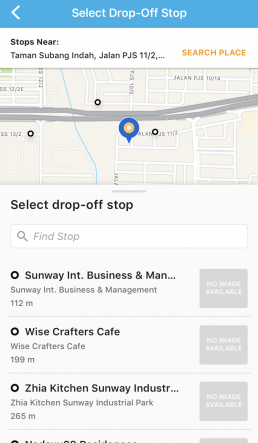
Default drop-off stops near you.
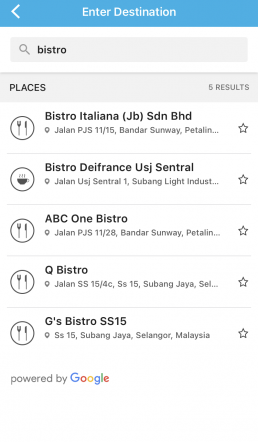
Searching for your destination.

Finding a drop-off point near your destination.
The experience of finding your drop-off destination is where the UI becomes incredibly confusing to use.
By default, you land on the map and a location search engine (powered by Google Maps). The app will assume your intended destination. From here, you have to click on the Search Place option on top. This will lead you to a destination search engine, by which you can find your destination and select it. But because it is also using Google Maps as its engine, keep in mind that any locations not available on Google Maps won’t be found here. In which case, you may need to rely on your geographical knowledge and search for the closest stops on the map itself.
Once you select your destination (marked by the blue location pin), it will show you the POI closest to your destination. Because of the way the map and its elements were designed, it took me a while to figure out the difference between the POI (marked by the black and white dots), and my intended destination. The latter could benefit from a text pop-up showing to the user where their actual destination is, instead of relying on a blue location pin.
This is especially because the user’s location itself is designated by a blue point. A bit of thinking behind the colour schemes used, as well as visual prompts would be a good point of improvement for the next update.
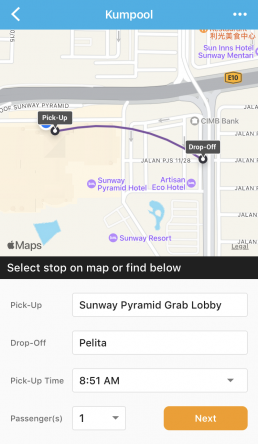
Journey confirmation.
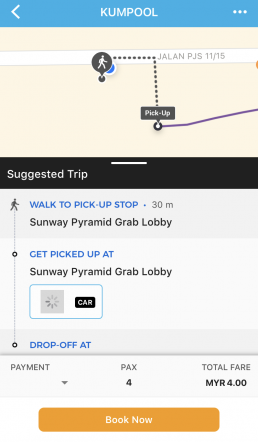
Access to pick-up point.
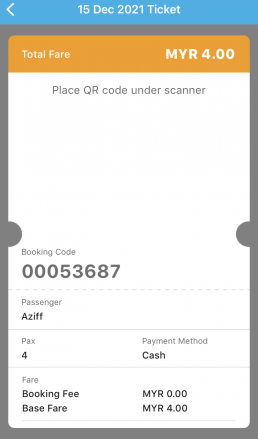
Digital QR ticket.
Once you have confirmed your destination and drop-off point, the app will bring you to a payment option. For now, it is only between paying by cash or topping up the in-app wallet. I would highly suggest opting for cash as in-app wallet features are usually slightly unstable. In which case, I would always suggest keeping spare change around.
The fare per person is RM1 per journey, which is very affordable and reasonable. You can also book up to 10 passengers on a single trip, which is useful if you travelling with others. It means that the app user can book for others in their party – which is convenient as only one designated person can be the one arranging the trip. It saves having others from needing to download the app and making the same trips themselves.
After confirming your booking, you will be directed on how to get to your pick-up point. One neat feature I do like about the step-by-step instructions is that it accesses Google Street View so you can know how your pick-up/drop-off area looks like, and navigate better. This is useful if you are new to the area and are unsure how and where to get around. However, that day while I was using the app, the images were loading slowly – which may or may not be the result of having too many pictures to load in the interface.
You will also have a QR ticket (mine was not showing that day – a bug, perhaps?) which will be scanned by the driver before entering the vehicle.
The ride
When your journey is confirmed, you will also be given details of your driver and the vehicle. The standard practice applies here: the information given is the vehicle number plate, and the driver’s details such as their name and a photograph. Of course, identifying your vehicle isn’t too difficult as all the Kumpool ride-share minivans have a distinct design with their name written on it.
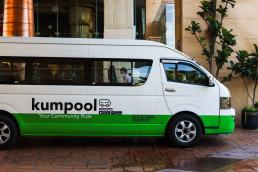
The mini-van is a 16-seater and is rather spacious inside. Though because of pandemic Standard Operating Procedures (SOPs), the van will only allow up to 10 passengers. There is a good distance between the passengers. Of course, you are also expected to wear your mask throughout the entire trip. Speaking of interiors, there is also air-conditioning inside the van, which is a must in hot and humid Malaysia. In my entire 15-minute ride, the journey was comfortable and pleasant. The minivan was also in good running condition, as there was no noticeable sign of age whether in-vehicle sound or movement.

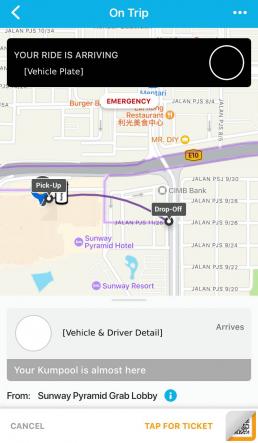
Vehicle and driver details. As well as proposed journey route.

Driver’s details.
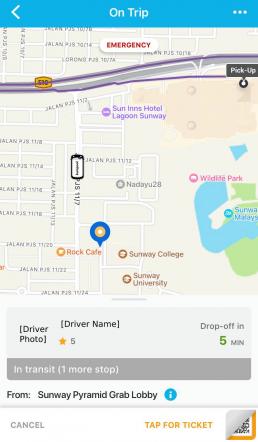
Discrepancy between your real-time location and the vehicle’s.
When it comes to tracking your journey on the app, the interface would show you the ideal journey path taken. This, however, functions more as a suggestion. Our driver took a route that was arguably closer and shorter – ignoring the app’s suggested routing algorithm (which I suspect is powered either by Google or Open Source Routing Machine, ORSM). While I am generally fine with drivers taking better routes (I trust their experience), depending on your comfort level, this may or may not be a desired aspect of the journey. I would suggest talking to your driver about this beforehand.
The second issue I observed during the journey is that the real-time location of the vehicle does not match up to the actual location. If you look at the third photo, On Trip, it shows our current location (designated by the blue pin), and the vehicle’s supposed location (designated by the top-view van icon). This may have more to do with the connection on the driver’s phone: which is either not refreshing as frequently or does not have a good internet connection. This is not a deal-breaker, but again, you are particular over such details, this may be something to consider.
Apart from those two in-app issues, the journey was alright. We are dropped off at the stop we selected earlier. In other words, the entire experience generally met expectations.
Can minivan ridesharing take off?
It is worth considering that as of now, Grab holds the largest market share of ride-sharing services in Malaysia. While this is limited mostly to cars, its success nevertheless, is rooted in being able to bridge the first-last mile gap that feeder buses otherwise couldn’t. So where does this put Kumpool?
While the minivan on-demand ride-sharing company has enjoyed reasonable success in Johor Bahru, there is a legitimate question of whether it can serve a Klang Valley market. Firstly, the use of minivans is not common among commuters. Last year, Prasarana piloted a feeder van service (Route T252) which as of now, appears to have been discontinued as it is no longer officially available on the service provider’s website and journey planner.
Kumpool, in some ways, evokes the van sapu service, an informal feeder van service similar to Indonesia’s angkot. Van sapu, for those who don’t know it – are private vehicle services that usually ferry commuters within a set route. They are typically unlicensed, which sometimes makes them the bane of licensed transport service providers and authorities. As informal as van sapu is, there is a part of the informal transport landscape and offer services where sometimes feeder buses could not.
The difference with Kumpool, of course, is that it is a legitimate service provider. And it has embraced the technological aspect of being on-demand via the use of an app. Certainly, Kumpool has the potential to fill a large gap that is otherwise left empty by transport service providers like Prasarana and Grab. Due to its minivan service, Kumpool’s potential target users could be the elderly and students. In an urban township like Subang, Kumpool could be a useful and affordable first-last mile bridge, as well as a direct transport service.
We were told that Subang would be their first Klang Valley pilot before they consider expanding into other urban townships. I suspect that in this regard, sprawled out townships would not be ideal because it would decrease the likelihood of getting more passengers. On top of the fact that Subang is: 1) a mature township, with 2) a good number of university-colleges spread across the township, 3) It is also adequately served by the LRT Kelana Jaya line, and 4) has a good number of commercial and entertainment centres. All these factors make Subang an ideal place to pilot this mobility service.
However, there are several challenges in Kumpool’s way as well. Firstly, is the commuter’s inclination towards using minivans as a first-last mile option. Over the years, minivans have been piloted as a potential first-last mile option, such as Asia Mobiliti. But can it surpass on-demand ride-sharing car services? There are several causes of concern:
- Users are anxious about ride-sharing. By this, I mean sharing spaces with others in their commutes. Since the pandemic, public transportation had suffered a major decrease in ridership and has not recovered since. Even for ride-sharing services like Grab, the pandemic saw drivers shifting over the deliveries instead due to lock-down restrictions. Even as Malaysia enters the endemic stage and these restrictions are lifted, the anxiety to take shared transport modes is a real concern for users. Proof of this is the increase in private vehicle purchases since 2020. Users prefer the safety of driving in their own spaces where the chances of being infected by the virus is less likely.
- Vans as a specific mobility mode. Minivans are often the preferred mode of transport for schools, retirement homes or companies. The association with vans is typical of it being a shuttle service for either students, workers or organisation members. Though informal services like van sapu exist, it is not as widely adopted as Indonesia’s similar angkot service. This association may be a challenge Kumpool needs to consider.
And of course, Malaysians are generally car-users. Public transport mode share among Malaysians is at 21%, with the rest preferring to take private vehicles. This will remain to be the biggest challenge for anyone who tries to enter the transport market. Grab’s advantage is that it leverages this car-use culture, and encourages existing car owners to earn money through the ride-sharing business. This advantage does not exist with transport operators who run bus or minivan services.
Pros
- Affordable at RM1/trip
- On-demand service
- Covers the entire of Subang
- Vehicles are spacious and comfortable
- Can book ride for others
Cons
- User interface can be confusing and messy
- In-app wallet not stable
- POIs and destination search not intuitive
- Vehicle/rider’s real-time info isn’t updated frequently
- Images like QR or location images do not load
I am aware that at this stage of the pilot, Kumpool is still testing their product and are ironing out any kinks in both the app and the service itself. The issues I mentioned earlier will no doubt be dealt with as they become more familiar with Subang and its user base.
I really do want Kumpool to succeed, because we need better first-last mile services. Particularly those not centered on private vehicle use that is unsustainable in the long run. So, if you’re in Subang, I highly recommend giving the service a try. Bring some friends along, because that is the whole point of the service, after all.
Thank you, Kumpool team, for inviting us to try out your ride-sharing service. All the best, moving forward!
You can download the Kumpool app in the iOS Apple Store or in the Google Play Store. You can also visit their website to learn more about them.
